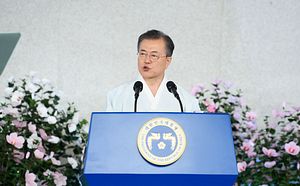Last week, South Korean President Moon Jae-in embarked on a pre-scheduled tour of three mainland Southeast Asian states. The trip put the spotlight on the Southeast Asia component of the Moon administration’s ‘New Southern Policy,’ and more specifically on its efforts to boost engagement in the Mekong subregion – a shorthand for the area in mainland Southeast Asia through which the Mekong River, one of the world’s longest and largest rivers, runs.
As I have noted before in these pages, while South Korea’s interest in Southeast Asia and ASEAN is far from new – Seoul has long been a leading trade and investment partner and a recognized Asian power – one of Moon’s expressed priorities since coming to office was to increase South Korea’s focus on Southeast Asia and ASEAN still further, partly under the broader banner of the so-called New Southern Policy. And while it is still early days in this initiative, we have seen some efforts to translate rhetoric into reality, both in terms of ASEAN-wide efforts as well as specific Southeast Asian states.
One notable dimension of South Korea’s engagement with Southeast Asia and ASEAN has been its focus on the Mekong. While Seoul, along with other actors such as the United States, has long recognized the Mekong subregion as being strategically significant – providing aid as well as setting up new mechanisms over the past few years such as the Mekong-ROK Foreign Ministers’ Meeting and the Mekong-ROK Business Forum – Moon has attempted to boost South Korea’s engagement in the Mekong still further. Efforts have already been underway to that end since he took office, with the expected holding of an inaugural Mekong-Korea Summit in late November alongside an ASEAN-South Korea Special Summit commemorating the 30th anniversary of the establishment of ASEAN-ROK relations expected to cap these achievements and upgrade cooperation.
Last week, the Mekong dimension of South Korea’s New Southern Strategy was in the headlines again with Moon’s visit to several mainland Southeast Asian countries. Moon was on a subregional tour from September 1 to September 6 that took him to Laos, Myanmar, and Thailand in an effort to boost bilateral relationships with these countries, unveil South Korea’s wider approach to the Mekong subregion, and to emphasize his administration’s continued commitment to expand ties with Southeast Asia.
The trip was laden with both symbolism and substance. Symbolically, Moon was keen to emphasize it as a sign of the importance of Southeast Asia in South Korea’s foreign policy, emphasizing that with the trip, he had effectively fulfilled his pledge to visit all the ten members of the Association of Southeast Asian Nations (ASEAN) during his administration earlier than scheduled. Substantively, each of the legs of the trip saw a mixed focus on announcing new deliverables and highlighting ongoing cooperation, laying the groundwork for the two aforementioned events in late November: the ASEAN-ROK Commemorative Summit and the Mekong-Korea Summit in Busan (the inclusion of Thailand, for instance, was additionally significant in that the country holds ASEAN’s annually rotating chairmanship for 2019).
Each of the legs of the trip warrant attention on their own terms – Moon and his administration emphasized various aspects of relations in a calibrated fashion including historical and cultural links, the role of Southeast Asian states in the management of inter-Korean relations, and new initiatives such as the groundbreaking ceremony for the Korea-Myanmar Industrial Complex.
But in terms of South Korea’s wider approach to the Mekong and Southeast Asia more generally, of particular note was Moon’s unveiling in Laos of what was termed the “Republic of Korea-Mekong Vision” to promote common prosperity comprising of three prongs: sharing South Korea’s experiences in rural development and technological change; advancing sustainability in areas such as forest conservation and water resource development; and promoting peace by moving beyond economic cooperation and into other areas including people-to-people exchanges, culture, and tourism.
To be sure, the focus on the deliverables of the trip can overstate the opportunities in South Korea’s Mekong engagement and underestimate the challenges that remain for it. While the Moon administration deserves credit for recognizing that the Mekong remains an important subregion to engage as part of a wider approach to Southeast Asia, South Korean officials also understand that the operating environment has also gotten more contested over the past few years due to a confluence of developments, including China’s rising influence and concerning governance challenges in some mainland Southeast Asian countries.
Additionally, while Moon’s three-pronged ROK-Mekong vision does begin to flesh out South Korea’s approach to the Mekong subregion – he made particular reference to projects, be it an LNG import terminal in Vietnam or a smart city pilot in Malaysia – there is still work left to do in more specific aspects, be it tying old and new projects to functional areas across countries or fleshing out the comparative advantages that Seoul brings to the table relative to other actors involved there such as Japan or Australia.
We will likely see more specifics disclosed in South Korea’s approach to the Mekong subregion in the lead up to the inaugural Mekong-Korea Summit and, thereafter, some of which may offer clearer answers to lingering questions about Seoul’s efforts. But Moon’s trip was an engagement that nonetheless highlighted his administration’s continued commitment to Southeast Asia in general and the Mekong more specifically even amid its other priorities both at home and abroad.
































